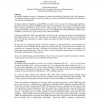Free Online Productivity Tools
i2Speak
i2Symbol
i2OCR
iTex2Img
iWeb2Print
iWeb2Shot
i2Type
iPdf2Split
iPdf2Merge
i2Bopomofo
i2Arabic
i2Style
i2Image
i2PDF
iLatex2Rtf
Sci2ools
CSDA
2008
2008
Step-up and step-down procedures controlling the number and proportion of false positives
In multiple hypotheses testing, it is important to control the probability of rejecting "true" null hypotheses. A standard procedure has been to control the family-wise error rate (FWER), the probability of rejecting at least one true null hypothesis. For large numbers of hypotheses, using FWER can result in very low power for testing single hypotheses. Recently, powerful multiple step FDR procedures have been proposed which control the "False Discovery Rate" (expected proportion of Type I errors). More recently van der Laan, Dudoit and Pollard (2004) proposed controlling a generalized family-wise error rate k-FWER (also called gFWER(k)), defined as the probability of at least (k+1) Type I errors (k=0 for the usual FWER). Lehmann and Romano (2005) suggested both a single-step, and a step-down procedure for controlling the generalized family-wise error rate. They make no assumptions concerning the p-values of the individual tests. The step-down procedure is simple t...
| Added | 10 Dec 2010 |
| Updated | 10 Dec 2010 |
| Type | Journal |
| Year | 2008 |
| Where | CSDA |
| Authors | Paul N. Somerville, Claudia Hemmelmann |
Comments (0)

